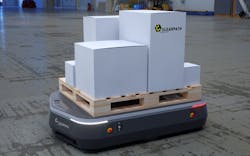With all the coverage in the news about driverless cars and humanoid robots, the advance of industrial robotics sometimes gets lost in the mix. But steady advances are being made in the industrial robotic sector—increasingly via multi-company collaborations. Evidence of this can be seen in recent announcements from Mitsubishi Electric and Yaskawa.
Through a partnership with Codian Robotics, Mitsubishi Electric’s MELFA range of compact SCARA and articulated arm robots is being extended by the addition of Codian Robotics’ new delta style robots. These delta robots are designed for lightweight pick-and-place tasks and can work autonomously using servo control or integrated into a Mitsubishi Electric automation environment.
This collaboration between Codian Robotics and Mitsubishi Electric developed as a result of the e-F@ctory Alliance partnership, a Mitsubishi Electric initiative where companies work together to create automation solutions.
Codian Robotics’ delta robots are constructed using materials such as carbon fiber, titanium, anodized aluminum, 316 stainless steel and plastics to make them lightweight and easy to use in the packaging and manufacturing industries. Mitsubishi Electric points out that these delta robots are best suited for common 3-axis top-loading packaging applications and push-fit assembly operations. A waterproof model made of hygienically approved materials is available for wash-down environments such as food & beverage, cosmetic and pharmaceutical applications.
In other industrial robotic collaboration news, Yaskawa and Clearpath have partnered to combine the capabilities of the Motoman MH12 robot equipped with end-of-arm tooling (EOAT) and vision system and Clearpath’s Otto 1500 self-driving vehicle. This combination of products is designed for mobile machine tending and material movement in shop floor environments.
The MH12 robot features a 12 kg payload capacity, hollow wrist for EOAT cable management and a 1,440 mm horizontal reach. Its design reportedly provides higher speed, longer reach and increased payload over current mobile manipulator products offered by competitors.
The Otto 1500 offers a payload capacity of 3,300 lbs. and is built with industrial grade components.
This combination of products from Yaskawa and Clearpath will reportedly provide “natural feature navigation, so there is no need to add fiducials or reflectors to the operating environment,” according to Yaskawa. The system will also be reconfigurable to accommodate changing operational preferences and/or changing facility infrastructure. It will be introduced at Automatica 2016 in Munich, Germany, June 21-24, 2016, at Yaskawa’s booth in Hall B6, booth 502.
“This autonomous modular solution provides users an alternative to arranging work around a fixed robot station,” says Roger Christian, divisional leader, new product development at Yaskawa Motoman.
In other robotic news, ABB announced that it has signed a contract with Finland’s Valmet Automotive for what it says is “the largest contract for industrial robots ever signed in Finland.” The 250 robots ordered by Valmet Automotive will be used to produce the new Mercedes GLC SUV at Valmet’s plant in Uusikaupunki, Finland. Production of the GLC SUV will begin in early 2017.
The new production line at Valmet Automotive line for this SUV is a greenfield project, which consists of the main lines and sub-assembly cells. Valmet’s order of ABB robots—which includes the IRB 6700 and IRB 8700 robots—brings the company’s total robot count to more than 500. Valmet says it ordered these robots to boost the company’s “flexible manufacturing, allowing it to enhance its operations by improving productivity and shortening lead-times.”
Leaders relevant to this article:


